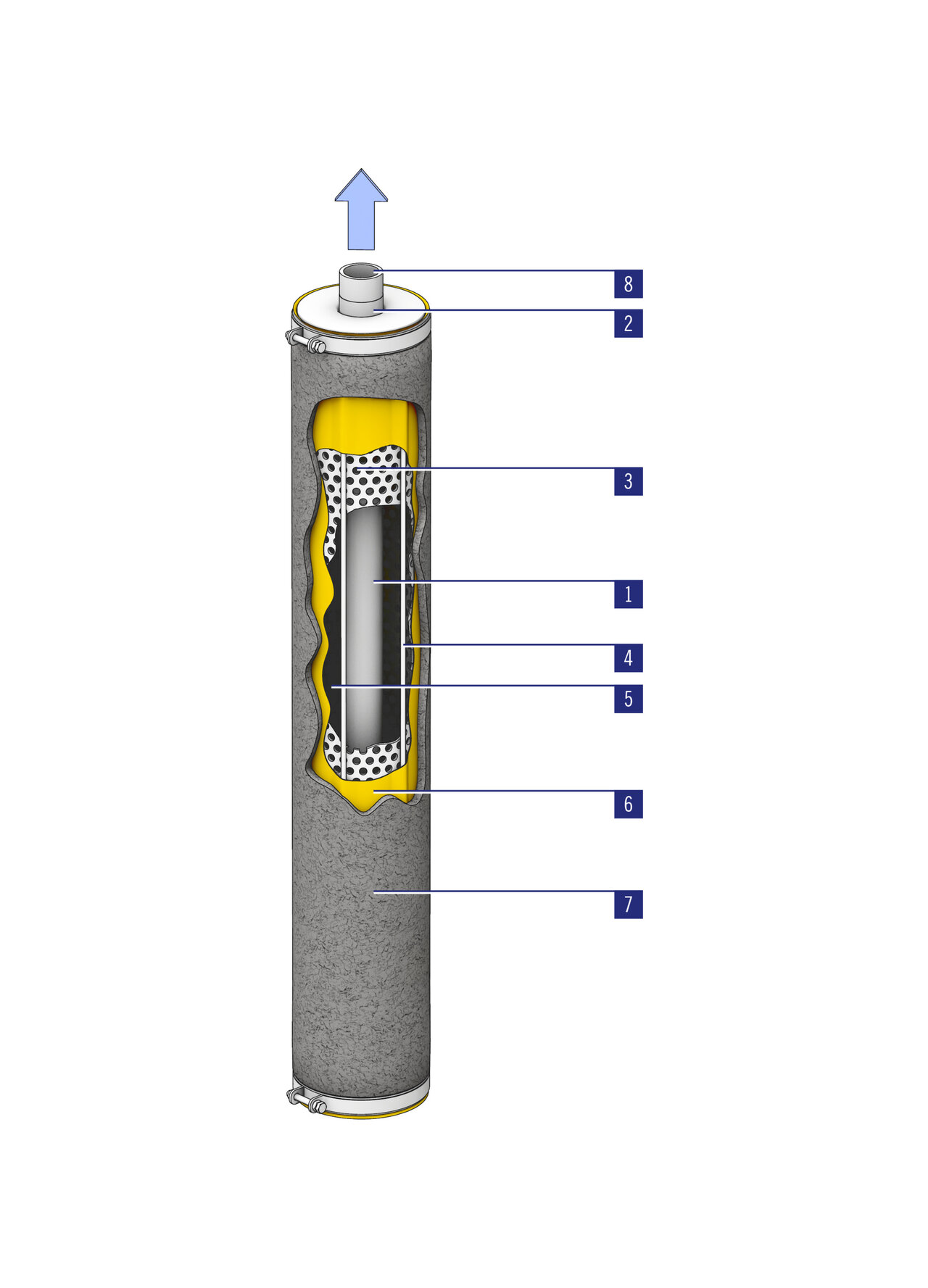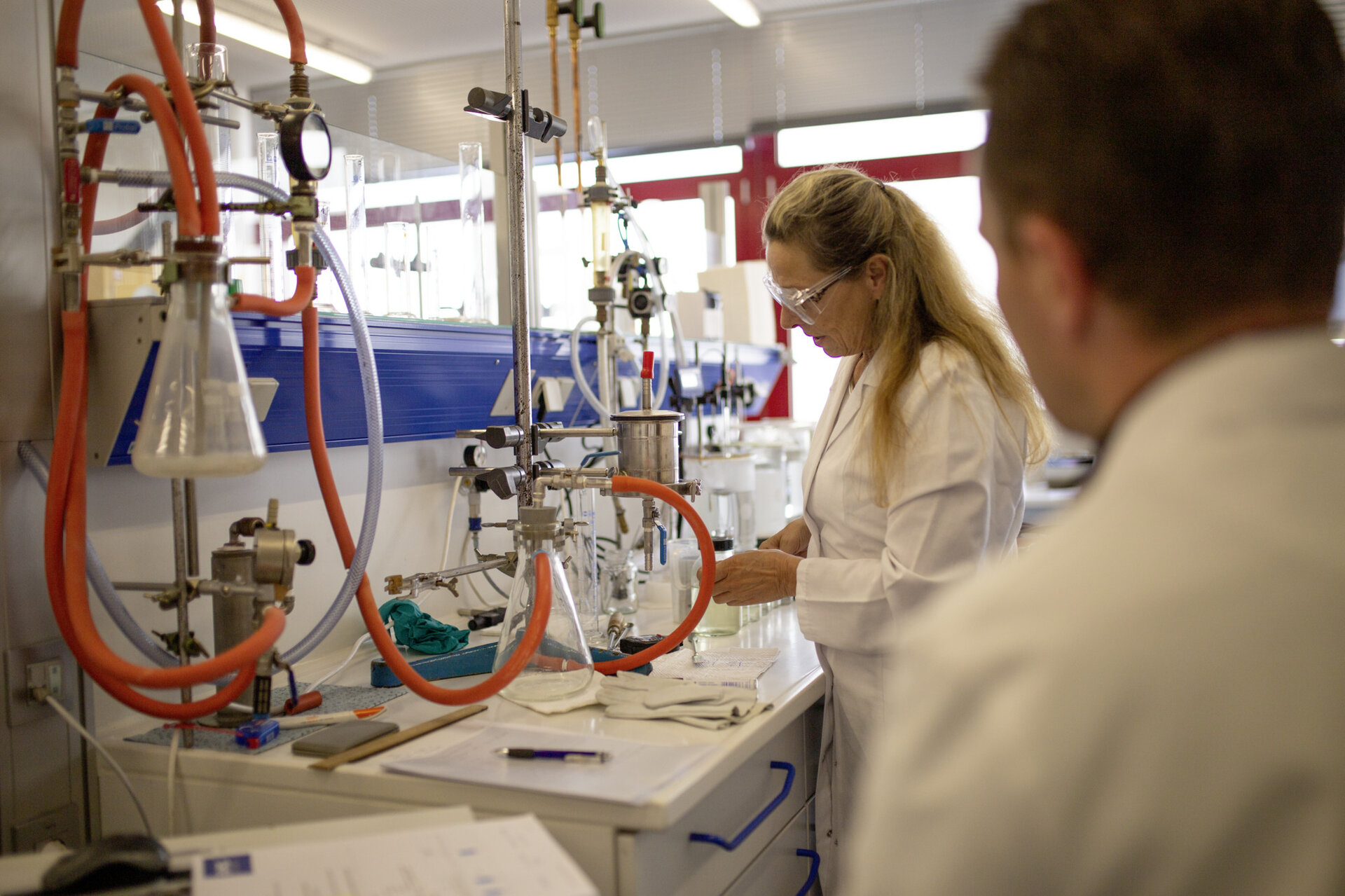
Candle filter

Candle filter
The candle filter of type CF is a filter that operates in a discontinuous manner. The candle-shaped filter elements are arranged vertically in a pressure vessel. The process steps typically performed with this unit are filtration, washing, drying and discharge. All these steps take place under pressure. The candle filter is used for the clarification of liquids with a low solids content. It is a compact unit, operates fully automatically and enables high throughput rates, dry cake discharge and a wide range of cake treatment options.
BHS candle filters are available in a standardized range with a variety of modules. 15 sizes with filter areas ranging from one to 87 square meters cover all common applications and market requirements - a flexible and cost-efficient solution for clarification filtration.
Highlights

Versatile technology solutions
In order to meet the respective process engineering requirements, the filter cake can be treated in many ways. It can be washed or slurried once or several times. To achieve further dehumidification of the filter cake, it is possible to pass air, nitrogen or other gases through it. If necessary, precoat filtration can be performed using filter aids.
Fully automatic operation
The candle filter works fully automatically. At the end of a process cycle, the filter cake is separated from the candle surface by means of a blow-back blast and discharged. Then, the next cycle begins.
Safe pressure filtration system
The entire filtration process takes place under pressure – up to a differential pressure of 6 bar g – in a closed, gas-tight system. This enables the use of BHS candle filters even under stringent safety or hygienic requirements. Products can also be processed in an inert or sterile atmosphere.
No moving parts
The BHS candle filter has no moving parts. This increases operational reliability and reduces the need for maintenance. When discharging the cake, the special surface design of each candle ensures that the cake fully separates before it is discharged downwards.
ATEX
ATEX-certified versions of the BHS candle filter are available for potentially explosive processes.
Technical systems

A Pressure vessel
B Suspension feeding
C Filtrate discharge
D Venting
E Compressed gas infeed
F Solids discharge
G Residual volume discharge
H Register pipes
I Filter candle
K Safety valve
L Pressure transducer
M CIP unit

1. Central pipe
The central pipe is designed as an immersion pipe that facilitates complete discharge of the filtrate.
2. Connection between candle and register
The candle is connected to the register via a thread at the end of the central pipe.
3. Support structure for filter medium
The support structure for the filter cloth is heavily perforated, which enables high filtrate throughput rates.
4. Pleating bars
The pleating bars cause the filter medium, and by extension the filter cake, to settle in a wave-like pattern. This results in stable, reliable cake formation.
5. Filtrate collection chamber
The filtrate is led downwards inside the support structure to the filtrate collection chamber. From there, it leaves the candle upwards via the central pipe.
6. Filter medium
During filtration, the filter medium is brought into a convex-concave wave shape by the pleating bars in combination with the working pressure applied.

Filtration
The solid matter (7) accumulates as a filter cake on the surface of the filter medium due to the pressure difference applied during the filtration cycle. The clear filtrate (8, blue arrow) flows upwards through the central pipe and is discharged through the register pipes.
Cake washing
Displacement or circulation washing can be implemented in the direction of the filtration.
Cake drying
Mechanical cake drying is implemented by blowing gas or steam through the filter cake. Alternatively, the cake can be discharged as sludge.
Cake discharge
At the end of the process cycle, the container is no longer under pressure and the discharge flap opens. To eject the filter cake (9), the filter cloth is expanded by means of blowback (10, orange arrow). The filter cake is ejected from the filter medium, breaks into pieces and falls through the discharge flap.
Accessories
Residual filtration device
Residual filtration devices are used to process the residual volume at the end of the filtration cycle via an internally filtering candle on the tank cone. In this way, complete residual filtration can be achieved while minimizing the expenditure of compressed gas.
Precoat or body feed system
A precoat or body feed system is required to stir powdered filter aids into a suspension. The precoat system works in batches, and the body feed system operates continuously. Both are of modular design and comprise a storage tank, agitator, piping, fittings, measuring instruments, steel structures and pumps.
Wet discharge with plate
In the case of wet discharge with plate, the candles are attached to a holding plate that separates the filtrate from the suspension chamber. The filter cake is discharged via filtrate counterflow. Under certain conditions, wet discharge with plate represents an economical solution.
Technical specifications
Performance data and dimensions
| Type | Candle length | Candle area | Number of candles | Active filter area (total) |
|---|---|---|---|---|
| CF 12 | 1.200 mm | 0,34 m² | 3 units | 1 m² |
| 7 units | 2,4 m² | |||
| 19 units | 6,5 m² | |||
| CF 18 | 1.800 mm | 0,51 m² | 19 units | 9,7 m² |
| 37 units | 18,9 m² | |||
| 61 units | 31,1 m² | |||
| CF 21 | 2.100 mm | 0,6 m² | 7 units | 4,1 m² |
| 61 units | 36,0 m² | |||
| 91 units | 53,7 m² | |||
| 127 units | 74,9 m² | |||
| CF 24 | 2.400 mm | 0,68 m² | 19 units | 12,9 m² |
| 37 units | 25,2 m² | |||
| 61 units | 41,5 m² | |||
| 91 units | 61,9 m² | |||
| 127 units | 86,4 m² |
All specifications apply to the standard version. Technical data for customized designs may differ from the specified data. All technical data may change due to development. Subject to modification without notice.
Operating criteria
| Operating method | intermittent |
|---|---|
| Operating pressure | up to 6 bar (g) |
| Operating temperature | up to 80 °C |
| Solids content (suspension) | up to 10 % (wt.) |
| Cake thickness | up to 30 mm |
| Particle size | 0,5 µm and above |
| Filter performance – suspension | 0,1 to 10 m³/m² h |
| Filter performance – dry solids | - |
| Active filter surface (total) | 1 to 86,4 m² |
































































